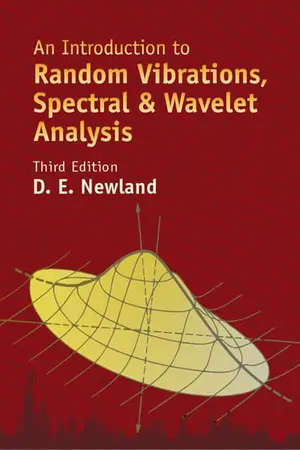
eBook - ePub
An Introduction to Random Vibrations, Spectral & Wavelet Analysis
Third Edition
- 512 pages
- English
- ePUB (mobile friendly)
- Available on iOS & Android
eBook - ePub
About this book
One of the first engineering books to cover wavelet analysis, this classic text describes and illustrates basic theory, with a detailed explanation of the workings of discrete wavelet transforms. Computer algorithms are explained and supported by examples and a set of problems, and an appendix lists ten computer programs for calculating and displaying wavelet transforms.
Starting with an introduction to probability distributions and averages, the text examines joint probability distributions, ensemble averages, and correlation; Fourier analysis; spectral density and excitation response relations for linear systems; transmission of random vibration; statistics of narrow band processes; and accuracy of measurements. Discussions of digital spectral analysis cover discrete Fourier transforms as well as windows and smoothing. Additional topics include the fast Fourier transform; pseudo-random processes; multidimensional spectral analysis; response of continuous linear systems to stationary random excitation; and discrete wavelet analysis.
Numerous diagrams and graphs clarify the text, and complicated mathematics are simplified whenever possible. This volume is suitable for upper-level undergraduates and graduate students in engineering and the applied sciences; it is also an important resource for professionals.
Starting with an introduction to probability distributions and averages, the text examines joint probability distributions, ensemble averages, and correlation; Fourier analysis; spectral density and excitation response relations for linear systems; transmission of random vibration; statistics of narrow band processes; and accuracy of measurements. Discussions of digital spectral analysis cover discrete Fourier transforms as well as windows and smoothing. Additional topics include the fast Fourier transform; pseudo-random processes; multidimensional spectral analysis; response of continuous linear systems to stationary random excitation; and discrete wavelet analysis.
Numerous diagrams and graphs clarify the text, and complicated mathematics are simplified whenever possible. This volume is suitable for upper-level undergraduates and graduate students in engineering and the applied sciences; it is also an important resource for professionals.
Frequently asked questions
Yes, you can cancel anytime from the Subscription tab in your account settings on the Perlego website. Your subscription will stay active until the end of your current billing period. Learn how to cancel your subscription.
At the moment all of our mobile-responsive ePub books are available to download via the app. Most of our PDFs are also available to download and we're working on making the final remaining ones downloadable now. Learn more here.
Perlego offers two plans: Essential and Complete
- Essential is ideal for learners and professionals who enjoy exploring a wide range of subjects. Access the Essential Library with 800,000+ trusted titles and best-sellers across business, personal growth, and the humanities. Includes unlimited reading time and Standard Read Aloud voice.
- Complete: Perfect for advanced learners and researchers needing full, unrestricted access. Unlock 1.4M+ books across hundreds of subjects, including academic and specialized titles. The Complete Plan also includes advanced features like Premium Read Aloud and Research Assistant.
We are an online textbook subscription service, where you can get access to an entire online library for less than the price of a single book per month. With over 1 million books across 1000+ topics, we’ve got you covered! Learn more here.
Look out for the read-aloud symbol on your next book to see if you can listen to it. The read-aloud tool reads text aloud for you, highlighting the text as it is being read. You can pause it, speed it up and slow it down. Learn more here.
Yes! You can use the Perlego app on both iOS or Android devices to read anytime, anywhere — even offline. Perfect for commutes or when you’re on the go.
Please note we cannot support devices running on iOS 13 and Android 7 or earlier. Learn more about using the app.
Please note we cannot support devices running on iOS 13 and Android 7 or earlier. Learn more about using the app.
Yes, you can access An Introduction to Random Vibrations, Spectral & Wavelet Analysis by D. E. Newland in PDF and/or ePUB format, as well as other popular books in Technology & Engineering & Applied Sciences. We have over one million books available in our catalogue for you to explore.
Information
Table of contents
- Title Page
- Copyright Page
- Table of Contents
- Preface to the first edition
- Preface to the second edition
- Preface to the third edition
- Acknowledgements for the first edition
- Acknowledgements for the second edition
- Acknowledgements for the third edition
- List of symbols
- Chapter 1 - Introduction to probability distributions and averages
- Chapter 2 - Joint probability distributions, ensemble averages
- Chapter 3 - Correlation
- Chapter 4 - Fourier analysis
- Chapter 5 - Spectral density
- Chapter 6 - Excitation - response relations for linear systems
- Chapter 7 - Transmission of random vibration
- Chapter 8 - Statistics of narrow band processes
- Chapter 9 - Accuracy of measurements
- Chapter 10 - Digital spectral analysis I: Discrete Fourier transforms
- Chapter 11 - Digital spectral analysis II: Windows and smoothing
- Chapter 12 - The fast Fourier transform
- Chapter 13 - Pseudo random processes
- Chapter 14 - Application notes
- Chapter 15 - Multi -dimensional spectral analysis
- Chapter 16 - Response of continuous linear systems to stationary random excitation
- Chapter 17 - Discrete wavelet analysis
- Appendix 1 - Table of integrals used in the calculation of mean square response (Chapter 7)
- Appendix 2 - Computer programs
- Appendix 3 - The Gaussian probability integral
- Appendix 4 - Distribution of
- Appendix 5 - Random numbers
- Appendix 6 - Distribution of reverse arrangements for a random series
- Appendix 7 - Wavelet programs
- Problems
- Answers to problems
- References
- Index